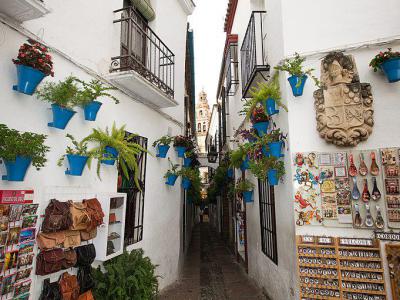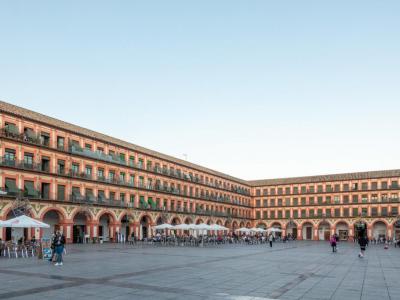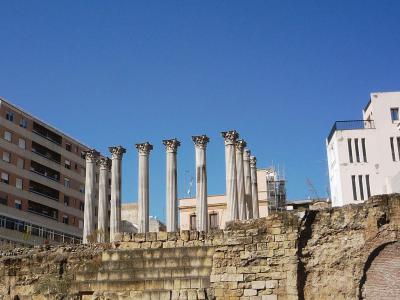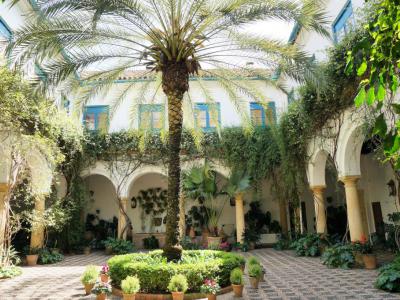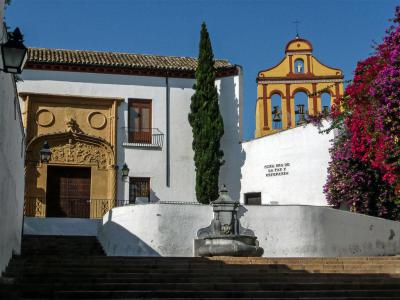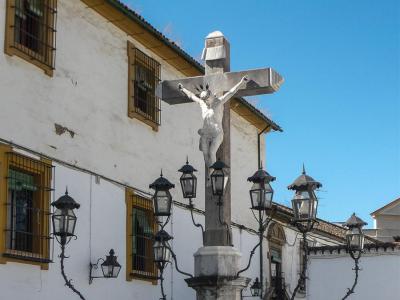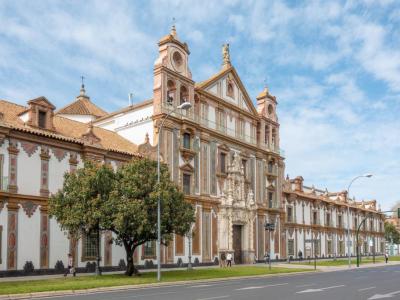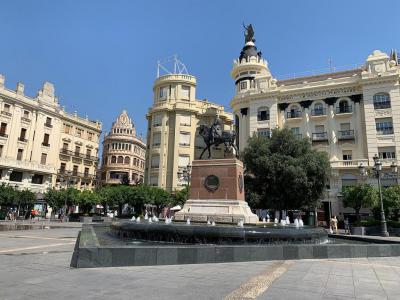Custom Walk in Cordoba, Spain by daveauvinen_c3dfa created on 2025-03-12
Guide Location: Spain » Cordoba
Guide Type: Custom Walk
# of Sights: 10
Tour Duration: 2 Hour(s)
Travel Distance: 3.9 Km or 2.4 Miles
Share Key: 729VF
Guide Type: Custom Walk
# of Sights: 10
Tour Duration: 2 Hour(s)
Travel Distance: 3.9 Km or 2.4 Miles
Share Key: 729VF
How It Works
Please retrieve this walk in the GPSmyCity app. Once done, the app will guide you from one tour stop to the next as if you had a personal tour guide. If you created the walk on this website or come to the page via a link, please follow the instructions below to retrieve the walk in the app.
Retrieve This Walk in App
Step 1. Download the app "GPSmyCity: Walks in 1K+ Cities" on Apple App Store or Google Play Store.
Step 2. In the GPSmyCity app, download(or launch) the guide "Cordoba Map and Walking Tours".
Step 3. Tap the menu button located at upper right corner of the "Walks" screen and select "Retrieve custom walk". Enter the share key: 729VF
1) Calleja de las Flores (Alley of the Flowers)
Just off the main artery of Córdoba’s historic centre-close enough to the Mosque-Cathedral to hear its bells stretch-there’s a street with a long name and a short introduction. It’s called Ricardo Velázquez Bosco, and if you spot a fading Arabesque carving near the curb, congratulations: you’ve found the entrance to the Alley of the Flowers. This narrow, cobbled alleyway is famous for its picturesque beauty, with whitewashed walls adorned with vibrant flower pots overflowing with seasonal blooms.
Walls on both sides are whitewashed so bright they could double as light reflectors, and every window grid competes in a silent showdown of vines, reds, and ivy-green. The path snakes to a tiny courtyard, where the Mosque-Cathedral’s bell tower politely photobombs every frame. There’s a fountain tucked in a corner, modest in size but serious in pedigree-its column once belonged to a Roman structure, now still trickling away as it has for decades.
Architect Victor Ucelay gave the whole scene a tune-up in the 20th century. He swapped in local river stones for paving, threw in some granite slabs for good measure, and arched a few doorways to complete the look. The red geraniums and green pots weren’t part of the instructions, but the neighborhood made sure they showed up anyway.
Come early May, when Córdoba’s flowers are busy taking over the city, this narrow alley hums with restraint. Birds handle the melody, the Cathedral chimes in occasionally, and the fountain-always on time-keeps rhythm in the square.
Walls on both sides are whitewashed so bright they could double as light reflectors, and every window grid competes in a silent showdown of vines, reds, and ivy-green. The path snakes to a tiny courtyard, where the Mosque-Cathedral’s bell tower politely photobombs every frame. There’s a fountain tucked in a corner, modest in size but serious in pedigree-its column once belonged to a Roman structure, now still trickling away as it has for decades.
Architect Victor Ucelay gave the whole scene a tune-up in the 20th century. He swapped in local river stones for paving, threw in some granite slabs for good measure, and arched a few doorways to complete the look. The red geraniums and green pots weren’t part of the instructions, but the neighborhood made sure they showed up anyway.
Come early May, when Córdoba’s flowers are busy taking over the city, this narrow alley hums with restraint. Birds handle the melody, the Cathedral chimes in occasionally, and the fountain-always on time-keeps rhythm in the square.
2) Calleja del Panuelo (Handkerchief Alley)
The Handkerchief Alley also known as Calle de Pedro Jiménez, is one of the most touristy streets in the city of Córdoba. It is located very close to the Mosque-Cathedral and Calleja de las Flores. It is also considered the narrowest street in the capital of Córdoba and one of the narrowest in Europe. It is part of the historic center of Córdoba, which was declared a UNESCO World Heritage Site in 1994.
The street gets its name from the length of the old handkerchiefs that gentlemen wore in the lapels of their suits (about 50 centimeters), as it would coincide exactly with the width of the street. The official name of the street, Pedro Jiménez, is said to come from the soldier of the Flanders Tercios who brought with him the Pedro Ximénez grape variety, very famous in Andalusia. Even on the same street, some grapevines can be found.
The street leads to a dead-end plaza, made of typical cobblestones, where there is a fountain made of baked clay with a niche, which used to be decorated with tiles and faces an Arab-origin well. Remains of an ancient column, some orange trees that provide shade, and houses that used to belong to the Cabildo due to their proximity to the main temple can be seen. Some of them still belong to the Cabildo, such as the one inhabited by the Company of Saint Teresa of Jesus, whose entrance is located in Plaza de la Concha.
In 1953, during the mayoralty of Antonio Cruz-Conde, this street was paved, illuminated with lamps, flower beds were built for the planting of orange trees and climbing plants, and a fountain with an Arab-style wellhead was made.
The street gets its name from the length of the old handkerchiefs that gentlemen wore in the lapels of their suits (about 50 centimeters), as it would coincide exactly with the width of the street. The official name of the street, Pedro Jiménez, is said to come from the soldier of the Flanders Tercios who brought with him the Pedro Ximénez grape variety, very famous in Andalusia. Even on the same street, some grapevines can be found.
The street leads to a dead-end plaza, made of typical cobblestones, where there is a fountain made of baked clay with a niche, which used to be decorated with tiles and faces an Arab-origin well. Remains of an ancient column, some orange trees that provide shade, and houses that used to belong to the Cabildo due to their proximity to the main temple can be seen. Some of them still belong to the Cabildo, such as the one inhabited by the Company of Saint Teresa of Jesus, whose entrance is located in Plaza de la Concha.
In 1953, during the mayoralty of Antonio Cruz-Conde, this street was paved, illuminated with lamps, flower beds were built for the planting of orange trees and climbing plants, and a fountain with an Arab-style wellhead was made.
3) Plaza del Potro (Colt Square)
Colt Square is a historic public square located in the district of Axerquia in the city of Cordoba. The square derives its name from a beautiful Renaissance fountain located in its center, which features a decorative figure of a colt with its front legs raised and holding a sign with the coat of arms of the city. The fountain dates back to 1577, and the colt was added to it a century later.
In the past, Colt Square served as a place for trading cattle and a hub for artisans. The famous Posada del Potro, located on one side of the square, is a building that was mentioned in Don Quixote by Cervantes. The building is now a museum that showcases the rich history of the area.
On the other side of the square are two museums - the Fine Arts Museum and the Julio Romero de Torres Museum. The former exhibits a vast collection of artwork, while the latter is dedicated to the works of the renowned painter Julio Romero de Torres, who was born in Cordoba.
In 1924, a monument dedicated to the Triumph of the Archangel Raphael was added to the other end of the square, creating a beautiful contrast with the Renaissance fountain. The square is rectangular in shape and is surrounded by charming buildings that add to its historical charm.
Despite its historical significance, Plaza del Potro remains a popular gathering place for locals and tourists alike. Visitors can enjoy the stunning architecture, take a stroll around the square, or simply relax at one of the cafes and restaurants that line its perimeter. The plaza also hosts various events throughout the year, making it a vibrant and lively destination in the heart of Cordoba.
In the past, Colt Square served as a place for trading cattle and a hub for artisans. The famous Posada del Potro, located on one side of the square, is a building that was mentioned in Don Quixote by Cervantes. The building is now a museum that showcases the rich history of the area.
On the other side of the square are two museums - the Fine Arts Museum and the Julio Romero de Torres Museum. The former exhibits a vast collection of artwork, while the latter is dedicated to the works of the renowned painter Julio Romero de Torres, who was born in Cordoba.
In 1924, a monument dedicated to the Triumph of the Archangel Raphael was added to the other end of the square, creating a beautiful contrast with the Renaissance fountain. The square is rectangular in shape and is surrounded by charming buildings that add to its historical charm.
Despite its historical significance, Plaza del Potro remains a popular gathering place for locals and tourists alike. Visitors can enjoy the stunning architecture, take a stroll around the square, or simply relax at one of the cafes and restaurants that line its perimeter. The plaza also hosts various events throughout the year, making it a vibrant and lively destination in the heart of Cordoba.
4) Plaza de la Corredera (Corredera Square)
The Corredera Square is one of the most iconic squares in Cordoba. Its history dates back to the 17th century when it was built as a bullring, one of the oldest in Spain. However, its origins go back even further.
During the Roman era, the site was a marketplace and a meeting place for the citizens of Cordoba. After the Reconquista, the Catholic Monarchs granted the land to the city of Cordoba, and it was used as a place for local markets and fairs.
In 1570, under the reign of King Felipe II, the square was redesigned as a bullring. It became known as the "Plaza de los Toros" and quickly became a popular venue for bullfighting events. The bullring had a unique design, with three levels of arcades and a capacity of up to 10,000 spectators.
Over the years, the bullring underwent several renovations and upgrades. It was used for bullfights until the early 20th century when it fell into disuse. In the 1970s, the city of Cordoba decided to transform the bullring into a public square, and it was renamed Plaza de la Corredera.
Today, Corredera Square is a bustling square in the heart of Cordoba's historic district. It is surrounded by beautiful buildings with colorful facades, many of which house restaurants and bars. The square is a popular gathering place for locals and tourists alike, and it is often used for cultural events and concerts. It remains a symbol of Cordoba's rich history and vibrant culture.
During the Roman era, the site was a marketplace and a meeting place for the citizens of Cordoba. After the Reconquista, the Catholic Monarchs granted the land to the city of Cordoba, and it was used as a place for local markets and fairs.
In 1570, under the reign of King Felipe II, the square was redesigned as a bullring. It became known as the "Plaza de los Toros" and quickly became a popular venue for bullfighting events. The bullring had a unique design, with three levels of arcades and a capacity of up to 10,000 spectators.
Over the years, the bullring underwent several renovations and upgrades. It was used for bullfights until the early 20th century when it fell into disuse. In the 1970s, the city of Cordoba decided to transform the bullring into a public square, and it was renamed Plaza de la Corredera.
Today, Corredera Square is a bustling square in the heart of Cordoba's historic district. It is surrounded by beautiful buildings with colorful facades, many of which house restaurants and bars. The square is a popular gathering place for locals and tourists alike, and it is often used for cultural events and concerts. It remains a symbol of Cordoba's rich history and vibrant culture.
5) Templo Romano (Roman Temple)
During the expansion of the Cordoba City Hall in 1950, the remains of a Roman Temple (Templo Romano) were unearthed. It was not the only temple in town, but there was none like this one. It was 105 feet long and 53 feet wide. It was estimated that construction had begun during the reign of Emperor Claudius, perhaps around 50 AD.
The fashion of the temple was Pseudoperipterus (columns engaged and embedded on the walls except in the front) and Hexastyle (six free-standing columns supporting a portico). The columns were Corinthian. The area around the temple was estimated to be the site of the town's forum when the city was titled Colonia Patricia by Rome.
The primary construction material used was high-quality marble. There was marble in the walls, columns, roof, and entablature. The temple stood by the west walls in the center of an artificial terraced square. The square was closed on three sides. The front of the temple faced the neighboring circus. The temple fell into disuse in the 4th century.
The reconstruction work of the Roman Temple was carried out in the middle of the 20th century, between the 50s and 60s, performed by the archaeologist Antonio García Bellido and the architect Félix Hernándezed. The restored ruins of the Roman Temple consist of 12 massive columns standing evenly in a 3/4 square. At night the columns are illuminated in warm, changing colors.
The remains of the building are its foundation, the stairs, the altar, and some shafts of columns and capitals. The original fragments of the temple, such as parts of drums or capitals, can be seen. Some pieces are shown in the Archeological Museum. Others are planted at various places around town, such as a fluted Corinthian column in the Plaza de la Doblas.
The fashion of the temple was Pseudoperipterus (columns engaged and embedded on the walls except in the front) and Hexastyle (six free-standing columns supporting a portico). The columns were Corinthian. The area around the temple was estimated to be the site of the town's forum when the city was titled Colonia Patricia by Rome.
The primary construction material used was high-quality marble. There was marble in the walls, columns, roof, and entablature. The temple stood by the west walls in the center of an artificial terraced square. The square was closed on three sides. The front of the temple faced the neighboring circus. The temple fell into disuse in the 4th century.
The reconstruction work of the Roman Temple was carried out in the middle of the 20th century, between the 50s and 60s, performed by the archaeologist Antonio García Bellido and the architect Félix Hernándezed. The restored ruins of the Roman Temple consist of 12 massive columns standing evenly in a 3/4 square. At night the columns are illuminated in warm, changing colors.
The remains of the building are its foundation, the stairs, the altar, and some shafts of columns and capitals. The original fragments of the temple, such as parts of drums or capitals, can be seen. Some pieces are shown in the Archeological Museum. Others are planted at various places around town, such as a fluted Corinthian column in the Plaza de la Doblas.
6) Palacio de Viana (Viana Palace) (must see)
The Viana Palace (Palacio de Viana) was built in the 15th century by the Marquis of Villaseca. Although called a palace now, it started as a stately mansion. Over time, the aristocratic families who came to possess the building transformed it into a Renaissance palace. It was named Viana Palace after the last family to live in the house: the marquises of Viana.
In 1980 the palace was bought by Provincial Savings of Cordoba. It is now a museum open to the public. The facade was designed in the Mannerist style by architect Juan de Ochoa Méndez in the 16th century.
The ground floor holds the Mosaic Room, the Hall of Tables, and the Hall of Signatures. The Nobles Floor, above, is the Black Bedroom and the French Bedroom. The Portuguese Salon has a crystal chandelier, while the Dining Room features rare pottery. The Red Room has a portrait of Queen Victoria Eugenia by painter Joaquin Sorolla.
The Viana Palace has 12 patios or courtyards and a garden. The Receipt Patio has 16 Tuscan columns. The Patio of the Oranges has orange trees. The Patio of Bars has monumental bars. The Patio of Madame holds a nymph and fountain. The Pool Courtyard has a greenhouse.
The Courtyard Archive holds over 300,000 medieval records and documents. The Gate Courtyard, which used to be the carriage entrance, has a plaque of Hercules. The Columns Courtyard, installed in the 1980s, is a venue for events. The Garden covers 1,200 square meters; it houses a 400-year-old oak.
Viana Palace was declared Historical-Artistic National Monument in 1981.
In 1980 the palace was bought by Provincial Savings of Cordoba. It is now a museum open to the public. The facade was designed in the Mannerist style by architect Juan de Ochoa Méndez in the 16th century.
The ground floor holds the Mosaic Room, the Hall of Tables, and the Hall of Signatures. The Nobles Floor, above, is the Black Bedroom and the French Bedroom. The Portuguese Salon has a crystal chandelier, while the Dining Room features rare pottery. The Red Room has a portrait of Queen Victoria Eugenia by painter Joaquin Sorolla.
The Viana Palace has 12 patios or courtyards and a garden. The Receipt Patio has 16 Tuscan columns. The Patio of the Oranges has orange trees. The Patio of Bars has monumental bars. The Patio of Madame holds a nymph and fountain. The Pool Courtyard has a greenhouse.
The Courtyard Archive holds over 300,000 medieval records and documents. The Gate Courtyard, which used to be the carriage entrance, has a plaque of Hercules. The Columns Courtyard, installed in the 1980s, is a venue for events. The Garden covers 1,200 square meters; it houses a 400-year-old oak.
Viana Palace was declared Historical-Artistic National Monument in 1981.
7) Cuesta del Bailio (Bailio Slope)
Bailio Slope is an historical street, known for its stunning architecture, rich history, and beautiful views of the city. This steep street winds its way up a hill in the heart of the city. The street is lined with beautiful mansions, palaces, and historical buildings, many of which date back to the 16th and 17th centuries. The architecture of the street reflects a blend of Gothic, Renaissance, and Baroque styles, and is characterized by intricate stonework, ornate facades, and elegant balconies.
The street takes its name from the Bailio Palace, which is located at the top of the hill. The palace was built in the 16th century by the Bailio family, who were one of the most prominent families in Cordoba at the time. The palace is a stunning example of Renaissance architecture, and features beautiful gardens, a courtyard with a marble fountain, and a stunning facade adorned with intricate carvings and statuary.
Bailio Slope is located in the heart of Cordoba's historic center, and is a popular destination for tourists and locals alike. The street provides visitors with a glimpse into the city's rich history and cultural heritage, and offers stunning views of the city and its landmarks.
The street takes its name from the Bailio Palace, which is located at the top of the hill. The palace was built in the 16th century by the Bailio family, who were one of the most prominent families in Cordoba at the time. The palace is a stunning example of Renaissance architecture, and features beautiful gardens, a courtyard with a marble fountain, and a stunning facade adorned with intricate carvings and statuary.
Bailio Slope is located in the heart of Cordoba's historic center, and is a popular destination for tourists and locals alike. The street provides visitors with a glimpse into the city's rich history and cultural heritage, and offers stunning views of the city and its landmarks.
8) Cristo de los Faroles (Christ of the Lanterns)
Christ of the Lanterns is a beautiful and historical monument. The monument consists of a statue of Christ on a pedestal, surrounded by a series of elegant street lamps, or "faroles," which give the monument its name. The Cristo de los Faroles is a beloved and iconic symbol of Cordoba.
The statue of Christ that stands atop the monument is a beautiful example of Baroque art, and is widely considered to be one of the most impressive religious sculptures in Spain. The statue dates back to the 17th century and was originally located in the Church of San Francisco. It was moved to its current location in the 19th century, when the monument was built to commemorate the city's victory over the French in the Napoleonic Wars.
The Cristo de los Faroles is located in the heart of Cordoba's historic center, near the Plaza de las Tendillas and the Calleja de las Flores. The monument is surrounded by elegant buildings and historical landmarks, and provides visitors with a beautiful and memorable view of the city. At night, the street lamps surrounding the monument are lit up, creating a beautiful and romantic atmosphere that draws visitors from all over the world.
The statue of Christ that stands atop the monument is a beautiful example of Baroque art, and is widely considered to be one of the most impressive religious sculptures in Spain. The statue dates back to the 17th century and was originally located in the Church of San Francisco. It was moved to its current location in the 19th century, when the monument was built to commemorate the city's victory over the French in the Napoleonic Wars.
The Cristo de los Faroles is located in the heart of Cordoba's historic center, near the Plaza de las Tendillas and the Calleja de las Flores. The monument is surrounded by elegant buildings and historical landmarks, and provides visitors with a beautiful and memorable view of the city. At night, the street lamps surrounding the monument are lit up, creating a beautiful and romantic atmosphere that draws visitors from all over the world.
9) Palacio de la Merced (Palace of Mercy)
The Palace of Mercy is a magnificent palace located in the heart of Cordoba. It was built in the 18th century as a residence for the bishops of Cordoba.
The Palacio de la Merced is a stunning example of Spanish Baroque architecture, with its intricate façade, ornate stonework, and sweeping staircase. The palace's interior is equally impressive, with grand halls, beautifully decorated ceilings, and a rich collection of art and historical artifacts.
Visitors to the Palacio de la Merced can explore the palace's many rooms and galleries, learning about the history and culture of Cordoba and the surrounding region. The palace's art collection includes works by some of Spain's most famous artists, including Francisco de Zurbarán, Bartolomé Esteban Murillo, and Julio Romero de Torres.
In addition to its art collection, the Palacio de la Merced also houses a variety of offices and meeting spaces, serving as a hub for government and civic activity in Cordoba. With its rich history, stunning architecture, and cultural significance, the Palacio de la Merced is a must-visit destination for anyone interested in the history and culture of Cordoba and the wider region of Andalusia.
The Palacio de la Merced is a stunning example of Spanish Baroque architecture, with its intricate façade, ornate stonework, and sweeping staircase. The palace's interior is equally impressive, with grand halls, beautifully decorated ceilings, and a rich collection of art and historical artifacts.
Visitors to the Palacio de la Merced can explore the palace's many rooms and galleries, learning about the history and culture of Cordoba and the surrounding region. The palace's art collection includes works by some of Spain's most famous artists, including Francisco de Zurbarán, Bartolomé Esteban Murillo, and Julio Romero de Torres.
In addition to its art collection, the Palacio de la Merced also houses a variety of offices and meeting spaces, serving as a hub for government and civic activity in Cordoba. With its rich history, stunning architecture, and cultural significance, the Palacio de la Merced is a must-visit destination for anyone interested in the history and culture of Cordoba and the wider region of Andalusia.
10) Plaza de Las Tendillas (Tendillas Square)
Tendillas Square is a popular pedestrian area located between the historic quarter and modern business and financial district of Cordoba. The square is an ideal place to relax and hang out, thanks to the numerous restaurants, cafes, and benches located under the trees. In the middle of the square, there is a large fountain, and several trick fountains provide a refreshing atmosphere for children, especially on warm summer evenings.
The square is also known for the Tendillas Clock, which has been striking quarters since 1961. The clock is famous for ringing in the New Year and is a popular meeting point for thousands of revelers. Plaza de Las Tendillas regularly hosts various events, including the famous Christmas Market.
The surrounding area of the square has plenty of options to explore, including the ancient Roman Temple located only 200 meters east of the square. The Cruz Conde and Jesús María streets, two of Cordoba's favorite shopping streets, are perfect for a gentle stroll.
The square is surrounded by several buildings, including the Marín Fernández house built in 1926 in the modernist style on the corner of Gondomar street. Other notable buildings built around the same time include the La Unión y el Fénix building, the Telephone Central, and the Casa Colomera. In 1928, the Enríquez Barrios House was completed, ordered to be built by the Cordovan mayor to the architect Aníbal González, who was also building his famous Plaza de España in Seville at that time for the 1929 Ibero-American Exposition.
One of the square's most remarkable features is the Monument to the Great Captain, made in 1923 by the artist Mateo Inurria. The monument was originally located on the avenue of the Great Captain but was moved to the square in 1927, despite neighborhood opposition at first.
The square is also known for the Tendillas Clock, which has been striking quarters since 1961. The clock is famous for ringing in the New Year and is a popular meeting point for thousands of revelers. Plaza de Las Tendillas regularly hosts various events, including the famous Christmas Market.
The surrounding area of the square has plenty of options to explore, including the ancient Roman Temple located only 200 meters east of the square. The Cruz Conde and Jesús María streets, two of Cordoba's favorite shopping streets, are perfect for a gentle stroll.
The square is surrounded by several buildings, including the Marín Fernández house built in 1926 in the modernist style on the corner of Gondomar street. Other notable buildings built around the same time include the La Unión y el Fénix building, the Telephone Central, and the Casa Colomera. In 1928, the Enríquez Barrios House was completed, ordered to be built by the Cordovan mayor to the architect Aníbal González, who was also building his famous Plaza de España in Seville at that time for the 1929 Ibero-American Exposition.
One of the square's most remarkable features is the Monument to the Great Captain, made in 1923 by the artist Mateo Inurria. The monument was originally located on the avenue of the Great Captain but was moved to the square in 1927, despite neighborhood opposition at first.
